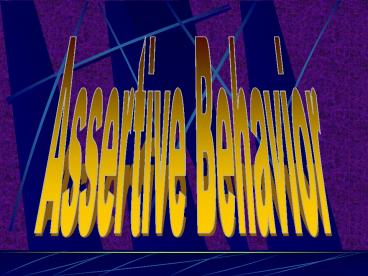Assertive Behavior PowerPoint PPT Presentation
Title: Assertive Behavior
1
Assertive Behavior
2
Assertiveness non-Assertiveness
- Assertiveness is best defined in relation to
aggressiveness and non-aggressiveness.
- Hidden messages (sending a message indirectly)
and bottling up feelings are forms of
Non-Assertiveness.
3
Use feeling-talk
- You can express your personal likes and
interests spontaneously rather than stating
things in neutral terms. You say I like this
soup or I love your blouse rather than This
soup is good. You can use the phrase I feel
and I think when it is appropriate.
4
Talk about yourself
- If you do something worthwhile and interesting,
you can let your friends know about it. You
dont monopolize the conversation,but you can
mention your accomplishments when it is
appropriate.
5
Make Greeting-talk
- You are outgoing and friendly with people you
want to know better. You smile brightly and
sound pleased to see them. You say, Hay! Its
good to see you rather than softly mumbling
Hello or nodding silently or looking
embarrassed.
6
Accept compliments
- You can accept compliments graciously (Yes, I
like this shirt, too) rather than disagreeing
with them (Oh, this old thing?). You reward
rather than punish your complimenter.
7
Use appropriate facial talk
- Your facial expressions and voice inflections
convey the same feelings your words do. - You can look people directly in the eye
when conversing with them.
8
Disagree mildly
When you disagree
with someone, you don't
pretend
to
agree for the sake of keeping the peace. You can
convey your
disagreement mildly by looking away, or
grimacing, or raising eyebrows
shaking your head, or changing the topic of
conversation.
9
Ask for clarification
- If someone gives you garbled directions,
instructions, or explanations, you can ask that
person to clarify. - Rather than going away confused and
feeling dumb, you can say, Your directions are
not clear to me. Would you please go over them
again?
PowerShow.com is a leading presentation sharing website. It has millions of presentations already uploaded and available with 1,000s more being uploaded by its users every day. Whatever your area of interest, here you’ll be able to find and view presentations you’ll love and possibly download. And, best of all, it is completely free and easy to use.
You might even have a presentation you’d like to share with others. If so, just upload it to PowerShow.com. We’ll convert it to an HTML5 slideshow that includes all the media types you’ve already added: audio, video, music, pictures, animations and transition effects. Then you can share it with your target audience as well as PowerShow.com’s millions of monthly visitors. And, again, it’s all free.
About the Developers
PowerShow.com is brought to you by CrystalGraphics, the award-winning developer and market-leading publisher of rich-media enhancement products for presentations. Our product offerings include millions of PowerPoint templates, diagrams, animated 3D characters and more.

